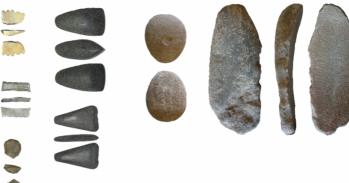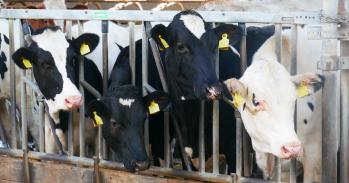
A discussion tomorrow will bring together some of the eminent archaeologists who studied at Cambridge in the 1960s and 1970s and went on to forge distinguished careers all over the world. The Bone Room’s Past is free, open to all, and culminates with a homemade tea served in the historic Sedgwick Museum.
A discussion tomorrow will bring together some of the eminent archaeologists who studied at Cambridge in the 1960s and 1970s and went on to forge distinguished careers all over the world. The Bone Room’s Past is free, open to all, and culminates with a homemade tea served in the historic Sedgwick Museum.
Bring a lot of interesting people together and give them tea and cake. The result is a meeting of minds – and all kinds of exciting things happen.
Pamela Jane Smith
A fascination for people’s stories, and the pathways that her fellow archaeologists have taken and the ways in which they have influenced the shape of the discipline, led Pamela Jane Smith to set up the Personal Histories Project in 2006. Canadian-born Dr Smith is an oral historian. She recently took formal retirement from her post but each year she and a group of student volunteers put on an event that brings Cambridge-educated scientists back to Cambridge to share their experiences, both with each other and with an audience of researchers, students and interested members of the public.
This year’s event, which takes place tomorrow in the Biffen Lecture Theatre and the Sedgwick Museum, is titled The Bone Room’s Past. It is free and open to all. The meeting will bring together a panel of eminent archaeologists from all over the world to discuss how their careers were shaped and inspired by what they learnt about the human past from handling and examining bones in a lab in the Department of Archaeology known as the Bone Room. It was later replaced by the handsome West Building of the McDonald Institute which houses among other things a state of the art lab (Clark Lab) in the same field, now known as zooarchaeology, the study of animal bones from archaeological excavations.
Much of the conversation is likely to focus on the contribution made by the pioneering archaeologist Eric Higgs, who set up the Bone Room. He inspired a generation of archaeologists to follow in his footsteps, into the laboratory and then into the field on his projects in Libya, Greece, Spain and Israel. Many of them contributed to the British Academy’s Major Research Project on the Early History of Agriculture which he directed.
Participants in tomorrow’s event will include many of Higgs’s past students who have gone on to forge distinguished careers in archaeology. Among them will be: Geoff Bailey, Anniversary Professor of Prehistoric Archaeology at the University of York; Charles Higham, Research Professor in the Department of Anthropology, University of Otago, New Zealand; Iain Davidson, Emeritus Professor of Archaeology in the School of Humanities at the University of New England, USA; Annie Grant, Dean of Students at the University of East Anglia; Graeme Barker, Disney Professor of Archaeology at Cambridge; and Tony Legge, Senior Fellow and Professor Emeritus in Environmental Archaeology, Cambridge.
All of these archaeologists studied under Higgs at Cambridge in the late 1960s and early 1970s and look back on their times with him, in the lab and out in the field, with huge affection and considerable gratitude for the encouragement he gave them. “He eschewed jargon and went straight to the point. When I was doing my PhD I went to his house in Panton Street for a supervision. He was watching Match of the Day and carried on watching it, but he made just one comment which struck right home and changed the course of the argument,” says Graeme Barker. “And when I once asked him for advice about my research career Eric puffed on his pipe for a few moments and then said sagely ‘I’ve always thought you work well in the heat!’ Advice which I followed with fieldwork in Italy, Greece, Libya and Jordan.”
It was the unconventional nature of Higgs’s career path that made him both a brilliant archaeologist and a talented teacher – a rare combination. It was Higgs who built up the collection of bones that became the Bone Room – a teaching resource that enabled generations of students to engage with the past in an entirely different way from the conventional stuff of archaeology at the time, typically dusty shards and bits of stone. Tony Legge explains: “Eric studied economics and then became a sheep farmer in Shropshire. He became fascinated by traditional methods of animal husbandry and that led him into archaeology. His hands-on experience of working on the land and of handling animals gave him practical insight into what must have been like to live with animals, and hunt and herd them.”
One of the aims of the Personal Histories Project is to allow today’s students to learn more about those who came before them – and, in particular, to appreciate the twists and turns that life stories can take. Tony Legge’s own career is a case in point, as he explains: “I was born less than 200 yards from the Department of Archaeology into a Cambridge family. I left school at 16 and went to work as a technician at what was then the Institute of Animal Physiology at Babraham. In the late 1950s I worked on Professor Graham Clark’s excavation at Hurst Fen. Higgs was his assistant there. I later saw Higgs on television and contacted him, He invited me to join a dig on Epirus, Greece. At the age of 27, having got some A levels, I went to Churchill College to study archaeology.”
Higgs changed the course of Geoff Bailey’s life too. He says: “I arrived at Cambridge in 1967 intending to study anthropology but changed to archaeology. The Bone Room, where Higgs sat at an old desk surrounded by trophy skulls, was an environment that fostered open debate and discussion. Higgs had a gift for giving his students a sense of purpose and making them feel that they could make a contribution. It was at Cambridge that I developed a lifelong interest in how people used landscapes - and in marine and coastal archaeology in particular.”
Graeme Barker, who is currently Head of the Department of Archaeology, also changed his career plans as a result on his encounter with Higgs. He says: “I came to Cambridge to study classics but swapped to archaeology after meeting Colin Renfrew, then a post-doctoral student and much later Disney Professor. Before I started the new course, I spent a month digging for Eric in his last season of cave excavation in Epirus in northwest Greece. His excavations and field projects were infamous for the appalling conditions in which his students had to live, but we ate and camped well, looked after splendidly by Eric’s wife Helen. We had to pay five shillings a day for the privilege of slaving in the cave, much to my parents’ horror. But I was hooked, I chose a special paper being taught for the first time that year by Eric on the origins of agriculture, and it set me on to one of the main strands of my research career.”
Working in the field brings teachers and students together in a way that doesn’t happen in the class room. The picture at the top was taken in 1971 by Jan Bay-Peterson in Rakafet Cave, the site of a Mesolithic settlement in Israel. Higgs is on the far right. Andy Garrard, the student in the photo with his elbows on his knees, is now a Senior Lecturer in Palaeolithic and Mesolithic Archaeology at the UCL Institute of Archaeology. He will be attending tomorrow’s event. Paul Wilkinson, far left in the photo, is now Vice-President Senior aux Affaires Environnementales et Sociales for the New Millennium Iron Corp in Montreal.
Tomorrow’s event will give undergraduates a chance to hear from and talk with many leading archaeologists in an informal setting. A bottle of wine will reward any undergraduate who asks a question. Hannah Sainsbury is one of the undergraduate students currently involved with the Personal Histories Project. She is in her final year and hopes to take a PhD masters in osteoarchaeology. She says that being involved in the project has given her the opportunity to meet some of the most eminent people in the archaeological and anthropological field – including Jane Goodall and Richard Wrangham. “Getting involved in the organisation of these events is a real learning curve, perhaps especially because Personal Histories has such a unique format. It’s a very interesting project and it’s accessible to everyone, which is very important,” she says.
A vital part of all Personal Histories Project meetings is the sharing of delicious food and drink. Tomorrow’s event will be followed by a “lovely tea” of cupcakes and lemon madeira cake, served in the historic setting of the Sedgwick Museum. As Pamela Jane Smith explains: “It’s quite a simple format really – you bring a lot of interesting people together, sit them down and give them tea and cake. The result is a meeting of minds – and all kinds of exciting things happen.”
The Bone Room’s Past takes place at the Biffen Lecture Theatre on the Downing Site, University of Cambridge, tomorrow (2 November) 1-3pm. The lovely tea will be served in the Sedgwick Museum at 3pm. No charge, open to all. For more information on the Personal Histories Project go to www.personalhistories.arch.cam.ac.uk or email pjs1011@cam.ac.uk.
This work is licensed under a Creative Commons Licence. If you use this content on your site please link back to this page.





